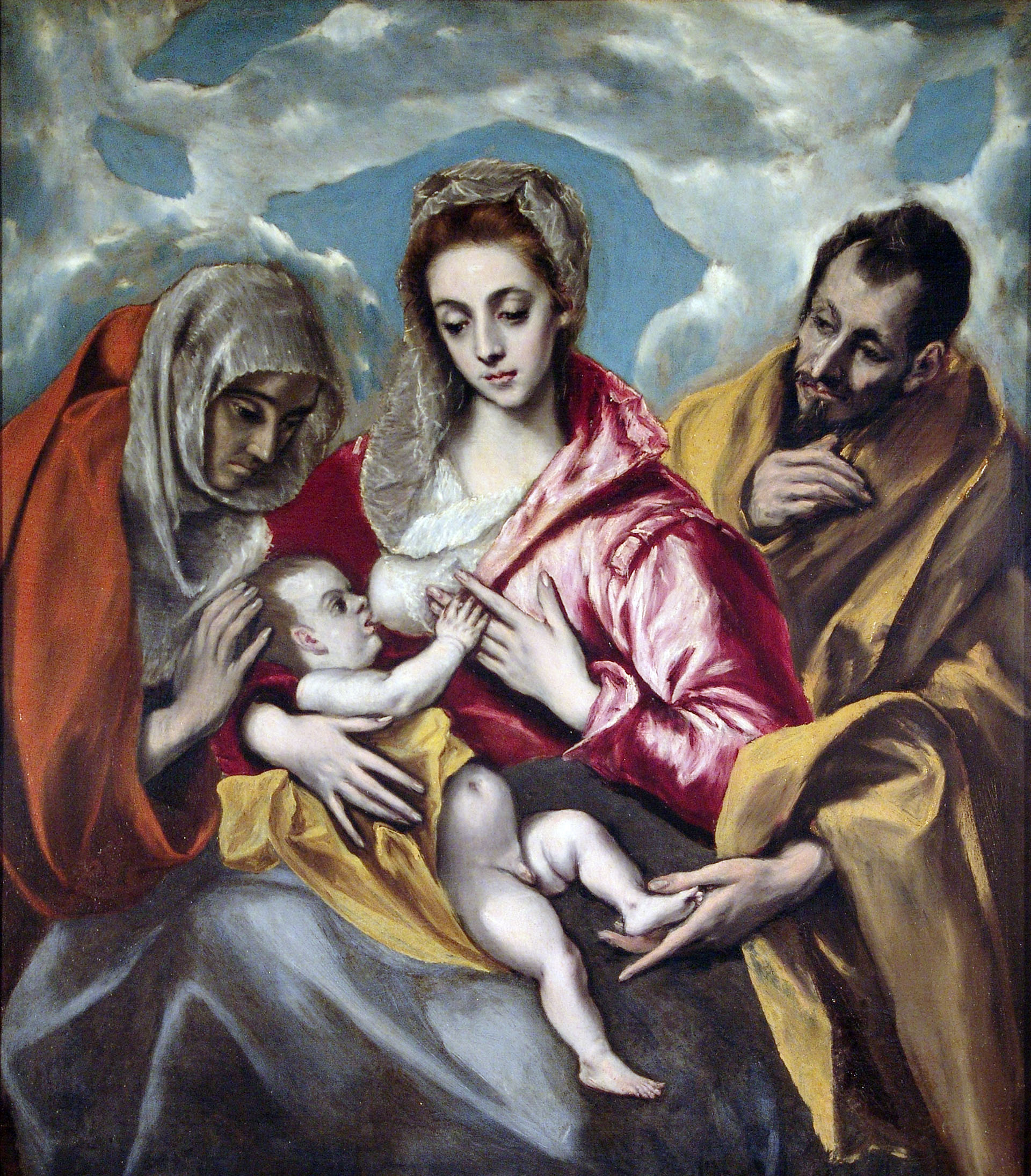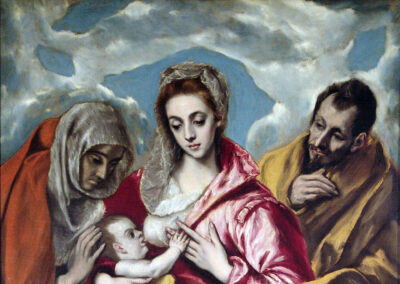This canvas of The Holy Family with Saint Anne (ca. 1595) by El Greco was donated to the Hospital de San Juan Bautista in Toledo by Teresa de Aguilera, widow of Alonso Capoche. It is already mentioned in an inventory of 1631 and may have been executed around 1595, according to the style and brushstroke, although not all historians share the same opinion and place the painting somewhat later in the chronology of El Greco's art. This oil painting of enormous artistic quality is at the same time a devotional painting typical of Counter-Reformation Spain, the success of which is attested to by the numerous versions and copies that have survived, with variations in format and figures. This version seems to have been originally based on the one now in the Hispanic Society in New York without Saint Anne.
The whole composition has a deliberate emotional and affective component, magnificently rendered by El Greco; if the Virgin's sweet, idealised face is considered by many critics to be one of the most beautiful of all the female images painted by El Greco, her composition is fully engaged emotionally and artistically thanks to the delicate interplay of hands that El Greco had already developed in The Spoliation of the Cathedral: Saint Anne gently caresses the head of the child, who clutches the fingers of his mother's left hand with her right hand, while Saint Joseph, at the other end of the canvas, touches Jesus' foot with his left hand. This protective activity of Saint Joseph, in the full maturity of his age, more than an old man, coincides with the new importance given to the putative father of Jesus by the most advanced currents of the Counter-Reformation.
Furthermore, the X-radiograph of this painting of The Holy Family in the Hospital Tavera can give us an idea, through its underlying drawing, of Dominico Greco's working method. El Greco first rendered the Virgin's face on the alla prima canvas in portrait form, for example, and then retouched it, stylising it and refining its features until he achieved an image of greater elegance, finesse and beauty that was more artistic but within the limits of a markedly naturalistic style.
From an iconographic point of view, the Virgin depicted is the Virgin of the Good Milk, and the scene shows at the same time, whether in Nazareth or during the stay in Egypt, provoked by the Slaughter of the Innocents and the Flight into Egypt, a mother breast-feeding a completely naked Christ Child, evidencing by her sexed character her human and not only divine nature. From an iconological point of view, this scene could be given a double symbolic meaning: on the one hand, the Virgin nourished Christ as the Church nourished her faithful, and on the other, by accepting both the virginal motherhood and the nourishment of the protagonist of the Redemption, Mary became the co-redeemer. Nevertheless, this episode from the tradition of the apocryphal Gospels would confirm the idea that El Greco was capable of taking liberties in his choice of religious sources, some of which, like the present one, were not accepted as fully orthodox and were therefore discouraged by the Counter-Reformation Church.
However, a less theological and doctrinal, but more human and educational interpretation of the iconography of this canvas could be at the origin of the dissemination of this theme of divine breastfeeding. Infant breastfeeding was a concern of the incipient Spanish paediatrician, from the protomedic of Philip II, Francisco de Valles (1524-1592), the historian and educator Juan de Mariana, the pedagogue Juan Huarte de San Juan and the Complutense professor Pedro García Carrero, to Jerónimo Soriano, author of a Methodo y orden de curar las enfermedades de los niños... (Zaragoza, 1600) or to Cristina (Zaragoza, 1600). (Zaragoza, 1600) or Cristóbal Pérez Herrera, who published his Defensa de las criaturas de tierna edad (Madrid, 1608), Francisco Pérez Cascales de Guadalajara, author of a Liber De Affectionibus puerorum (Madrid, 1611), and especially highlighted in the later work of Juan Gutiérrez de Godoy (1579-1656), a doctor from Gienna and chamber physician to Bishop Baltasar de Moscoso y Sandoval and from 1645 chamber physician to Philip IV. He published, dedicated to the Countess of Oropesa Doña Mencía Pimentel, his Tres discursos para prouar que están obligadas a criar sus hijos a sus pechos todas las madres quando tienen buena salud, fuerças y buen temperamento, buena leche y suficiente para alimentarlos (Jaén, 1629), a text in which he defended that "lhe milk of mothers in good health is the best milk"denounced "how cruel and unloving it is for mothers not to raise their children. They lack piety and religion"and warned of the "serious damage and disadvantages [that] result from rearing them on foreign milk". Naturally, in his desire for noblewomen to bring up their children themselves, he appealed to the nobility of his models, from those of ancient and modern queens to those of the Holy Scriptures, or the very Saint Anne and the Virgin Mary (II, iv, pp. 44-46), of whom even the saints had praised "all their children".also her beautiful breasts for having raised"Jesus, and after proving that her milk was not miraculous because she was a virgin, but fundamentally natural.
Fernando Marías, November 2008


